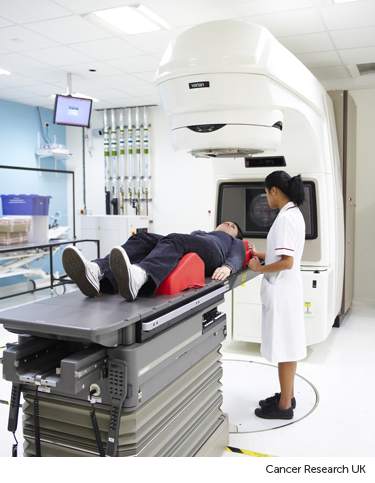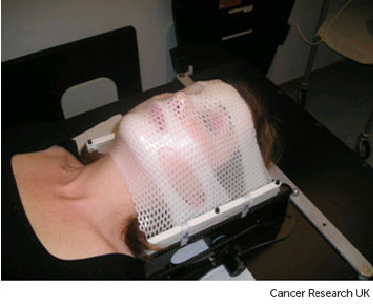Radiotherapy for secondary brain cancer
When cancer has spread to the brain from elsewhere in the body, it is called a secondary brain tumour or a brain metastasis.
Cancer growing inside the brain increases pressure inside the skull. This can cause symptoms such as:
-
a bad headache
-
sickness
-
increasing drowsiness
Radiotherapy is a common treatment for secondary brain tumours. It aims to shrink the cancer, relieve the pressure inside your skull, and reduce your symptoms.
Your doctor might suggest that you have radiotherapy to the whole of your brain. This is because it's likely that there might be cancer elsewhere in the brain that is too small to show up on a scan.
How you have treatment
You have radiotherapy to the brain as a course of daily treatments called fractions. It is likely to be 1 to 2 weeks of daily treatments. But this can vary.
You have a CT planning scan so the treatment team can plan exactly where to give the radiotherapy. For this scan you will have a mould made which helps to keep you in the right position. It also makes sure that the treatment is delivered accurately each day. They put marks on the mould to help with positioning you for the treatment.
Having treatment
To have the treatment you lie on a radiotherapy couch. The therapeutic radiographers help you to get into the right position.

It is very important that you keep perfectly still. You will have your plastic mould or mask to wear to help with this.
While you are lying down, the plastic mould is put over your face and head and onto the radiotherapy couch. It makes sure that you don’t move in the middle of your treatment.

Once you are in the correct position the radiographers then leave the room. This is so they are not exposed to the radiation. You will be alone for a few minutes while you have the treatment, but they can see and hear you the whole time.
It is important that you keep still and breathe normally. Sometimes there may be a delay in starting the radiotherapy. This is due to the radiographers taking an x-ray picture before treatment to check your position.
You won't feel anything during the radiotherapy. The radiotherapy couch is usually quite hard, which can be uncomfortable.
Some people with secondary brain cancers have stereotactic radiotherapy. This gives radiotherapy from many different positions around the body, with the radiation beams meeting at the tumour.
Treatment results
Radiotherapy treatment to control symptoms of brain cancer might take a few days or weeks to work. The radiotherapy might cause swelling at first. This might make your symptoms seem as though they are getting worse.
Your doctor will usually prescribe steroids during your radiotherapy to help with the swelling.
The radiotherapy might also help to stop new areas of cancer developing in the brain. So although you won't notice it, the treatment may be stopping the situation from getting worse.
Side effects of brain radiotherapy
Side effects of radiotherapy for brain cancer might not come on straight away. Side effects tend to come on gradually as you progress through your treatment and for a few weeks afterwards. They can include:
-
hair loss in the treatment area - it usually will grow back
-
skin reaction on the scalp
-
sickness - you can take anti sickness medicine during treatment to help
-
drowsiness
-
fits (seizures)
-
headaches
Tell your doctor or radiographers about any side effects you are experiencing. They can help you to manage them.
Radiotherapy can cause many different side effects, such as tiredness. The side effects you get will depend on the area you're having treatment to but there are some general side effects you might experience regardless of where your cancer is. This video is about the side effects you might have when having radiotherapy to the brain.
On screen text: Severe tiredness (somnolence)
Mary: You know, when you say you're tired, it's not like being tired. It's like you lose all of your energy and you just do something simple like having a shower and it's like you have to lie down or you have to rest.
Martin (radiographer): After completing brain radiotherapy, you may experience severe tiredness known as somnolence. This can occur about six weeks after treatment finishes.
Mary: That fatigue really hit me and it went on for a while afterwards as well. It didn't get worse. It just stayed.
Martin (radiographer): Symptoms of somnolence include extreme tiredness and slowed mental processing. To help you cope we would recommend listening to your body and trying not to overdo things but if you can do light exercise to help maintain your energy levels.
Mary: I just took a rest if I needed to and I had to learn not to be so hard on myself. But there is little things that you can do that I felt helped anyways. That little bit of exercise. Just going for them small walks. They really do help you and even if it is just walking around your house or just walking around the block, getting outside, just getting a bit of fresh air that really, really did help me.
On screen text:
- Rest and have short naps when you need to
- Drink plenty of water
- Eat a balanced diet
- Do some gentle exercise
- Try to get some fresh air
On screen text: Feeling or being sick
Mary: After the first two or three days of the radiotherapy, I started getting really bad nausea. As the radiotherapy went on, it was just kind of a constant. Every time I'd have it, I'd feel sick afterwards.
Martin (radiographer): If you do experience sickness, then speak with your team. They can prescribe medications to help with that.
Mary: I did ask my oncologist. I'll just explain to him that I'm feeling sick from this. Please, can I get something? And then they did. They prescribed me these anti sickness medication so that did help me a lot. You don't want to eat anything, but you have to. If you're going to keep your strength up, anything that aggravates your stomach or aggravates the nausea, don't go near that but if you don't eat even though you feel sick and you feel nauseous, then you're going to feel even worse.
On screen text:
- Ask your doctor about anti sickness medication
- Your doctor might prescribe you steroids to help with your sickness
- Relaxation techniques such as mindfulness and visualisation can help
- Certain food might make it worse, such as fried food
- Eat a few hours before treatment rather than just before
- Try sipping water or fizzy drinks throughout the day
On screen text: Hair loss
Martin (radiographer): Having radiotherapy to your head can cause hair loss in the area that we're treating. It's unlikely to be all over the head, more likely to be in patches.
Mary: 2 to 3 weeks after the radiotherapy I was brushing my hair and loads came out on the brush. I knew it was going to happen, but it was just hard when it happened.
Martin (radiographer): In many cases, the hair will grow back about two months after treatment finishes. The texture and the colour may be different to before.
Mary: Mine did grow back and there's a lot of grey in it so I have to dye it, this is not my original colour. It's very slow growing back. I would say use quite a sensitive shampoo, a baby shampoo. Use that for sensitive skin in your head.
Martin (radiographer): Protect the head from the sun and the wind and avoid using hair colour, hair dryer or straighteners to style your hair. If you experience substantial hair loss, then speak with your team who can give you information about wigs and hair coverings.
Mary: I got some really cool head scarves. There is some really nice ones out there.
On screen text:
- Be gentle with your hair
- Use a non-perfumed shampoo or baby shampoo
- Avoid using heat on your hair such as a hairdryer or hair straighteners
- Let hair dry naturally or gently pat dry with a soft towel
- Your radiographer can advise you on how to care for sore skin
- Speak to your radiographer about hair coverings and wigs
On screen text: Your symptoms might get worse
Martin (radiographer): Radiotherapy to the brain can cause swelling in the area that we're treating. If you already had symptoms before starting treatment, this swelling may make the symptoms worse. After you've finished treatment, the swelling may continue for a few more weeks, but then you should recover quite quickly.
On screen text:
- Your symptoms may get worse during treatment
- This might include headaches, sickness, fits, numbness and weakness in your hands and feet
- You might need steroids to help reduce the swelling
If you're experiencing a side effect that hasn't been covered in this video, you can find more information on the Cancer Research UK website.
On screen text: For more information go to: cruk.org/radiotherapy/side-effects



